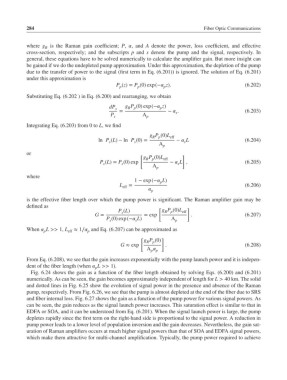Page 303 - Fiber Optic Communications Fund
P. 303
284 Fiber Optic Communications
where g is the Raman gain coefficient; P, , and A denote the power, loss coefficient, and effective
R
cross-section, respectively; and the subscripts p and s denote the pump and the signal, respectively. In
general, these equations have to be solved numerically to calculate the amplifier gain. But more insight can
be gained if we do the undepleted pump approximation. Under this approximation, the depletion of the pump
due to the transfer of power to the signal (first term in Eq. (6.201)) is ignored. The solution of Eq. (6.201)
under this approximation is
P (z)= P (0) exp(− z). (6.202)
p
p
p
Substituting Eq. (6.202 ) in Eq. (6.200) and rearranging, we obtain
dP s g P (0) exp(− z)
R p
p
= − . (6.203)
s
P A
s p
Integrating Eq. (6.203) from 0 to L, we find
g P (0)L eff
R p
ln P (L)− ln P (0)= − L (6.204)
s
s
s
A p
or
[ ]
g P (0)L eff
R p
P (L)= P (0) exp − L , (6.205)
s
s
s
A p
where
1 − exp(− L)
p
L = (6.206)
eff
p
is the effective fiber length over which the pump power is significant. The Raman amplifier gain may be
defined as [ ]
P (L) g P (0)L eff
R p
s
G = = exp . (6.207)
P (0) exp(− L) A p
s
s
When L >> 1, L eff ≈ 1∕ and Eq. (6.207) can be approximated as
p
p
[ ]
g P (0)
R p
G ≈ exp . (6.208)
A
p p
From Eq. (6.208), we see that the gain increases exponentially with the pump launch power and it is indepen-
dent of the fiber length (when L >> 1).
p
Fig. 6.24 shows the gain as a function of the fiber length obtained by solving Eqs. (6.200) and (6.201)
numerically. As can be seen, the gain becomes approximately independent of length for L > 40 km. The solid
and dotted lines in Fig. 6.25 show the evolution of signal power in the presence and absence of the Raman
pump, respectively. From Fig. 6.26, we see that the pump is almost depleted at the end of the fiber due to SRS
and fiber internal loss. Fig. 6.27 shows the gain as a function of the pump power for various signal powers. As
can be seen, the gain reduces as the signal launch power increases. This saturation effect is similar to that in
EDFA or SOA, and it can be understood from Eq. (6.201). When the signal launch power is large, the pump
depletes rapidly since the first term on the right-hand side is proportional to the signal power. A reduction in
pump power leads to a lower level of population inversion and the gain decreases. Nevertheless, the gain sat-
uration of Raman amplifiers occurs at much higher signal powers than that of SOA and EDFA signal powers,
which make them attractive for multi-channel amplification. Typically, the pump power required to achieve

